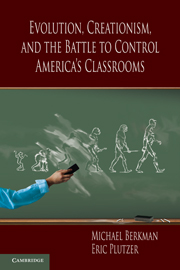Book contents
- Frontmatter
- Contents
- Figures
- Tables
- Acknowledgments
- Introduction
- 1 Who Should Decide What Children Are Taught?
- 2 The Public Speaks: “Teach Both”
- 3 A Nation Divided by Religion, Education, and Place
- 4 Is Evolution Fit for Polite Company? Science Standards in the American States
- 5 Teachers and What They Teach
- 6 State Standards Meet Street-Level Bureaucracy
- 7 When the Personal Becomes Pedagogical
- 8 Teachers in Their Schools and Communities
- 9 The Battle for America’s Classrooms
- Appendix to Chapter 2
- Appendix to Chapter 3
- Appendix to Chapter 4
- Appendix to Chapter 5
- Appendix to Chapter 6
- References
- Judicial Opinions and Court Cases Cited
- Index
8 - Teachers in Their Schools and Communities
Published online by Cambridge University Press: 05 June 2012
- Frontmatter
- Contents
- Figures
- Tables
- Acknowledgments
- Introduction
- 1 Who Should Decide What Children Are Taught?
- 2 The Public Speaks: “Teach Both”
- 3 A Nation Divided by Religion, Education, and Place
- 4 Is Evolution Fit for Polite Company? Science Standards in the American States
- 5 Teachers and What They Teach
- 6 State Standards Meet Street-Level Bureaucracy
- 7 When the Personal Becomes Pedagogical
- 8 Teachers in Their Schools and Communities
- 9 The Battle for America’s Classrooms
- Appendix to Chapter 2
- Appendix to Chapter 3
- Appendix to Chapter 4
- Appendix to Chapter 5
- Appendix to Chapter 6
- References
- Judicial Opinions and Court Cases Cited
- Index
Summary
There are worse things taught in our schools, and I will continue to support local control of education.
New Hampshire Governor Stephen Merrill (1995)In the previous chapter, we showed how the individual characteristics of teachers help explain their varied approaches to teaching evolution and why some teachers are willing to cross the constitutional line by treating creationism as a scientific alternative to evolutionary biology. To a large extent, the analyses suggest that the type of learning opportunities afforded to each of the nation's public school students is a chance event, based almost entirely on the particular teacher they encounter in their general biology class.
But such an interpretation would not tell the entire story. And that is because teachers are not randomly distributed across classrooms, nor are they as immune to community influences as they are to state content standards. In this sense, it is again useful to think of teachers as street-level bureaucrats who are entrusted to implement state policy while also being afforded substantial autonomy commensurate with their positions as credentialed professionals. In Chapter 6, we assessed the extent to which teachers are responsive to state standards – official policies that are crafted by state policy makers. These policy makers include those directly elected by the people, as well as political appointees and civil servants who will reflect various degrees of responsiveness to public opinion. In this chapter, we shift our focus from this top–down conception of democratic control to a bottom–up model (Meier and O’Toole 2006) and assess their responsiveness to the communities they serve.
- Type
- Chapter
- Information
- Publisher: Cambridge University PressPrint publication year: 2010



